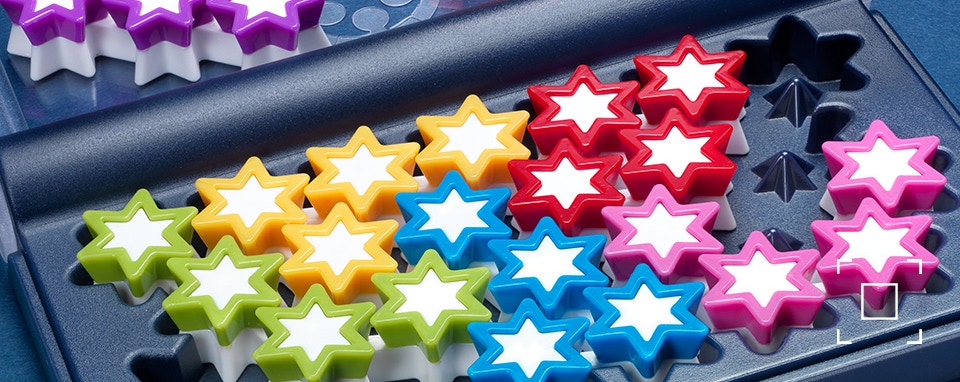
IQ-Stars
The story behind the creation of IQ-Stars
Raf Peeters, January 2018
Originally I designed IQ-Stars for 2019. SmartGames so far published 8 different IQ-puzzles, and maybe it was time for a break. But people at the office got more and more enthusiastic the closer the concept came to the final product. And so it ended up as a novelty for 2018 anyway. This means we probably take the break next year and won’t introduce a new IQ-puzzle in 2019 instead of 2018.
These IQ-games are becoming a nice subcollection of SmartGames. They all share the same size of game board and a similar “fill up the grid” concept, but they all look different and each game has it’s own characteristics. Like nobody in a family is the same, but you can still see that they are relatives.
When I choose a concept for SmartGames I always try to find a balance between more complex/ original ideas and very simple ones. Last year I developed IQ-Focus, which was one of the most difficult IQ-games. So this year I choose something more straight forward.
I wanted to do something with an hexagonal grid, because all current IQ-games are being played on an orthogonal grid (except IQ-Link). But I didn’t want to use hexagons, because they look boring in some way. Hexagons create a pattern that is too much in-your-face. I can’t help it, but for obvious reasons they always make me think of honeycombs.
I also wanted to design an IQ-game that looked less “adult” and “more fun”. That’s how I ended up with 6 pointed stars. By rotating each star a little bit, I could arrange them in an hexagonal grid, but avoided that it looked like a honeycomb.
A NEW STAR IS BORN
People have much more problems with hexagonal than with square grids. Probably because each puzzle piece can be orientated in 6 instead of 4 orientations. That’s why I choose puzzle pieces that can only be used on 1 side. There are 381 possible ways to fit all puzzle pieces on the game board. For the challenges I only needed 120, so you can always find different packings than the ones shown in the booklet.
The bottom side of the puzzle pieces is white. Part of this white is also visible in the centre of each star on the top side. The side of the puzzle pieces is slightly angled. This way the stars have an hour glass shape when you look at them from the side view. This makes placing and lifting up the puzzle pieces easier.

example of a easy challenge/solution of IQ-Stars

example of a difficult challenge/solution of IQ-Stars
GAME RULES IQ-STARS
The object of IQ-Stars is to fit all of the star puzzle pieces on the game grid.
1) Select a challenge. Place the star puzzle piece(s) as indicated (most challenges show you the position and color of one or more pieces to help you get started).
2) Place the remaining puzzle pieces on the game board:
- All pieces are single-sided. Always use the side with the colored stars facing upwards.
- Challenges in the advanced Wizard level show only the position and color of single stars (not full pieces).
Players must figure out the orientation of the piece that star is a part of.
- Puzzle pieces cannot overlap each other or the border of the game board.
3) There is only 1 possible solution, shown at the end of the booklet.
Website ©2018 Raf Peeters
Products and images: © Smart
